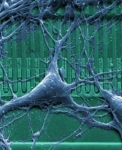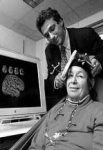Apr 18, 2006
Brain waves: Neurotechnology Revenues Reach $110 Billion
Via Brain Waves
According to the Neurotechnology Industry 2006 Report, neurotechnology revenues reach $110 Billion.
Produced by Neuroinsight, the report provides a unified market-based framework to help investors, companies and governments quantify opportunities, determine risks and understand the dynamics of this market.
20:01 Posted in Neurotechnology & neuroinformatics | Permalink | Comments (0) | Tags: Positive Technology
Apr 07, 2006
Cybervision
More than a million people in the United States are legally blind. Many of them once had vision but tragically lost it. Now a breakthrough device could give them back some of their sight.

read full article
10:59 Posted in Neurotechnology & neuroinformatics | Permalink | Comments (0) | Tags: Positive Technology
Mar 27, 2006
Medgadget: Neuro Semi-Conductor Interface
Via Medgadget

According to Information Society Technologies (IST), European investigators have created a novel interface between mammalian neurons and silicon chips. The development, achieved by the NACHIP project, funded by the EU Commission's Future and Emerging Technologies, is a "crucial first step in the development of advanced technologies that combine silicon circuits with a mammal's nervous system. "
From the press release:
The ultimate applications are potentially limitless. In the long term it will possibly enable the creation of very sophisticated neural prostheses to combat neurological disorders. What's more, it could allow the creation of organic computers that use living neurons as their CPU.Those applications are potentially decades away, but in the much nearer term the new technology could enable very advanced and sophisticated drug screening systems for the pharmaceutical industry.
"Pharmaceutical companies could use the chip to test the effect of drugs on neurons, to quickly discover promising avenues of research," says Professor Stefano Vassanelli, a molecular biologist with the University of Padua in Italy, and one of the partners in the NACHIP project, funded under the European Commission's Future and Emerging Technologies initiative of the IST programme.
NACHIP's core achievement was to develop a working interface between the living tissue of individual neurons and the inorganic compounds of silicon chips. It was a difficult task.
"We had a lot of problems to overcome," says Vassanelli. "And we attacked the problems using two major strategies, through the semiconductor technology and the biology."
21:08 Posted in Neurotechnology & neuroinformatics | Permalink | Comments (0) | Tags: Positive Technology
Mar 26, 2006
Smart Mobs: Bioengineering professor hopes to mimic the brain on a chip
Kwabena Boahen, an associate professor in the Department of Bioengineering, leads a research group that is trying to mimic the functions of the brain’s complex neural system using silicon chips.

Read the Stanford's report
20:19 Posted in Neurotechnology & neuroinformatics | Permalink | Comments (0) | Tags: Positive Technology
Mar 22, 2006
Advanced Course in Computational Neuroscience
August 7th – September 1st 2006, ARCACHON, FRANCE
The Advanced Course in Computational Neuroscience is for advanced graduate students and postdoctoral fellows who are interested in learning the essentials of the field.
We seek students of any nationality from a variety of disciplines, including neuroscience, physics, electrical engineering, computer science, mathematics and psychology. Students are expected to have a keen interest and basic background in neurobiology as well as some computer experience.
The course has two complementary parts. Mornings are devoted to lectures given by distinguished international faculty on topics across the breadth of experimental and computational neuroscience. During the rest of the day, students are given practical training in the art and practice of neural modelling, largely through the medium of their
individual choice of model systems.
The first week of the course introduces students to essential neurobiological concepts and to the most important techniques in modelling single cells, networks and neural systems. Students learn how to solve their research problems using software packages such as MATLAB, NEST, NEURON, XPP, etc. During the following three weeks the lectures cover specific brain areas and functions. Topics range from modelling single cells and subcellular processes through the simulation of simple circuits, large neuronal networks and system level models of the brain.
Applications, including a description of the target project must be submitted electronically (see below) and should be accompanied by the names and email details of two referees who have agreed to furnish references. Applications will be assessed by a committee, with selection being based on the following criteria: the scientific quality of the candidate (CV) and of the project, the recommendation letters, and evidence that the course affords substantial benefit to the candidate's training.
More information and application forms can be obtained from:
19:56 Posted in Neurotechnology & neuroinformatics | Permalink | Comments (0) | Tags: Positive Technology
Mar 13, 2006
Transcranial magnetic stimulation
Via Medgadget
 From Yale School of Medicine:
From Yale School of Medicine:
"It appears that stimulating populations of neurons once per second with Transcranial Magnetic Stimulation over many minutes modestly reduces the capacity of these neurons to activate each other," Hoffman said [Ralph Hoffman, M.D., a professor in the Department of Psychiatry and lead investigator of the study -ed.] "As a result, neural populations as a whole become less reactive or excitable. Our study findings suggest that hallucinations can be curtailed using this approach without interfering with normal brain function."
Hoffman recently completed a study testing TMS in different areas of the brain and found that positioning the TMS over what is known as Wernicke's region in the left temporal lobe, and a second region located on the opposite side of the brain, were optimal in reducing these hallucinations. He said these two brain areas, which ordinarily play key roles in perceiving words spoken by other persons, have also been found in other studies to be important in producing hallucinated "voices."
For patients enrolled in the trial, TMS will be administered to these brain areas once per second for 16 minutes daily over a three-week period. One-third of the subjects in the trial will start out receiving a placebo form of TMS. After three weeks, these subjects will also be offered a trial of real TMS. The study will use a magnetic resonance imaging brain scan to precisely position TMS over desired brain regions.
21:28 Posted in Neurotechnology & neuroinformatics | Permalink | Comments (0) | Tags: Positive Technology
Feb 23, 2006
1st International Summer School on Advanced Technologies for Neuro-Motor Assessment and Rehabilitation
(Deadline for application: 15th April 2006)
From the website:
The school intends to offer a large spectrum of advanced state-of-the-art on emerging technologies for the assessment and conditioning of human movement, with a particular emphasis on portable/wearable sensors and wireless technology. This Summer School is primarily addressed to researchers and professionals interested in the most recent advances of assistive and rehabilitation technologies for the neuro-motor function.
The program will include topics as:
- Portable sensors and systems
- Wireless communications
- Biofeedback devices
- Virtual Reality-based systems
- Virtual prototyping
The school is open to technical professionals, advanced undergraduates, graduate students and post docs with an interest in biomedical engineering, human movement science, physical and rehabilitation medicine, and related disciplines.
Application procedure on the website (deadline 15th April 2006)
Registration fee is 700 Euro and includes board, accommodation in double room, coffee breaks and study material.
11:32 Posted in Neurotechnology & neuroinformatics | Permalink | Comments (0) | Tags: Positive Technology
Feb 16, 2006
Neurotech Industry Investing and Business Conference
Via Brain Waves
May 18, 2006, Millbrae, California
Westin San Francisco Airport
The Neurotech Industry Investing and Business Conference is a business and investment conference for the neurotechnology industry including pharmaceuticals, medical devices and diagnostics.
 Keynotes presentations will focus on state of the neurotech industry, cutting edge company presentations, and panel discussions on a comprehensive selection of neurotech topics.
Keynotes presentations will focus on state of the neurotech industry, cutting edge company presentations, and panel discussions on a comprehensive selection of neurotech topics.
10:36 Posted in Neurotechnology & neuroinformatics | Permalink | Comments (0) | Tags: Positive Technology






